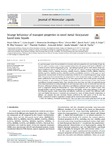Strange Behaviour of Transport Properties in Novel Metal Thiocyanate Based Ionic Liquids

Use este enlace para citar
http://hdl.handle.net/2183/28787
A non ser que se indique outra cousa, a licenza do ítem descríbese como Atribución-NoComercial-SinDerivadas 4.0 Internacional (CC BY-NC-ND 4.0)
Coleccións
- Investigación (FCIE) [1227]
Metadatos
Mostrar o rexistro completo do ítemTítulo
Strange Behaviour of Transport Properties in Novel Metal Thiocyanate Based Ionic LiquidsAutor(es)
Data
2021-08-03Cita bibliográfica
O. Cabeza, L. Segade, M. Domínguez-Pérez, E. Rilo, D. Ausín, J.A. Seijas, M.P. Vazquez-Tato, V. Matleev, A. Ievlev, J. Salgado, L.M. Varela, Strange behaviour of transport properties in novel metal thiocyanate based ionic liquids, 340 (2021) 117164. https://doi.org/10.1016/j.molliq.2021.117164.
Resumo
[Abstract] In a previous paper some of us presented the structure and some properties of a new family of ionic liquids, ILs, with a common cation, 1-butyl-3-methyl imidazolium (the popular [C4C1Im]⁺ or [BMIM]⁺) and a variety of anions based in thiocyanate (SCN)¯: one reference sample and ten with anionic metal complexes of different valences: Al¹¹¹, Mn¹¹, Fe¹¹, Cr¹¹¹, Ni¹¹, Hg¹¹, Zn¹¹, Co¹¹ and Cu¹, resulting, respectively, [BMIM](SCN), [BMIM]₃ Al(SCN)₆, [BMIM]₄ Mn(SCN)₆, [BMIM]₃ Fe(SCN)₆, [BMIM]₃ Cr(SCN)₆, [BMIM]₄ Ni(SCN)₆, [BMIM]₂ Hg(SCN)₄, [BMIM]₂ Zn(SCN)₄, [BMIM]₂ Co(SCN)₄ and [BMIM]₃ Cu(SCN)₄. In this paper we show experimental measurements of electrical conductivity of these ILs in a broad temperature range (about 90 K). Viscosity has been measured for six compounds in a wide temperature range. In addition, the diffusion coefficient for both ions forming the IL has been measured for some of the samples using NMR-Dosy technique. In spite of being very similar compounds from a chemical point of view, they present very different transport property values. Thus, viscosity varies more than two orders of magnitude among those metal thiocyanate ILs, being the highest for the compound with Al and the lowest for that with Hg. Moreover, differences between ionic conductivity and diffusion coefficient values extend more than one order of magnitude among the thiocyanate ILs. These three properties will be related in pairs, thus through Walden’s rule we compare molar conductivity and fluidity, while using Kohlrausch’s law and Nerst-Einstein equation molar conductivity and diffusion coefficient are related. Also, diffusion coefficient and fluidity (the inverse of viscosity) are compared by means of Stokes-Einstein relationship. In addition, we calculate the Laity interionic friction coefficients for both anions of the IL with Hg. Finally, a theoretical model is suggested to explain all the experimental evidences reported.
Palabras chave
Thiocyanate ionic liquids
Ionic conductivity
Viscosity
Diffusion coefficient
Ionic conductivity
Viscosity
Diffusion coefficient
Descrición
Financiado para publicación en acceso aberto: Universidade da Coruña/CISUG The following are the Supplementary data to this article: https://ars.els-cdn.com/content/image/1-s2.0-S0167732221018882-mmc1.docx
Versión do editor
Dereitos
Atribución-NoComercial-SinDerivadas 4.0 Internacional (CC BY-NC-ND 4.0)
ISSN
0167-7322






